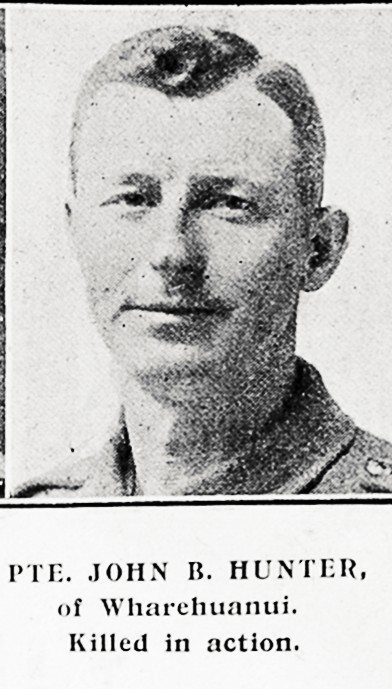Pte
John Boyd Hunter
Informations sur naissance
|
Date de naissance: 08/03/1889 |
|
Lieu de naissance: Arrowtown, Otago, New Zealand |
Informations générales
|
Profession: Agriculteur |
Informations service militaire
|
Pays: New Zealand |
|
Force armée: New Zealand Expeditionary Force |
|
Rang: Private |
|
Numéro de service: 9/1057 |
|
Incorporation date: 02/02/1915 |
|
Incorporation nom de lieu: Queenstown, Otago, New Zealand |
|
Unités: — Otago Regiment, 1st Bn. (Dernière unité connue) |
Informations sur décès
|
Date de décès: 03/12/1917 |
|
Lieu de décès: Polderhoek, Belgique |
|
Cause du décès: Killed in action (K.I.A.) |
|
Âge: 28 |
Cimetière
|
Buttes New British Cemetery, Polygon Wood Parcelle: I Rangée: D Tombe: 15 |
Distinctions et médailles 2
|
British War Medal Médaille |
|
Victory Medal Médaille |
Points d'intérêt 3
| #1 | Lieu de naissance | ||
| #2 | Lieu d'enrôlement | ||
| #3 | Lieu du décès (approximatif) |
Mon histoire
John Hunter Boyd was born on 8 March 1889 in Arrowtown, Otago, New Zealand, to Robert and Sarah Hunter. His middle name is recorded as ‘Boyne’ but on his attestation form he clearly signed as John Boyd Hunter. His birthdate is wrongly recorded on his army history sheet as 1887, a misreading of the correct date on his attestation form.
John enlisted on 2 February 1915 into the 5th Reinforcement, Otago Mounted Rifles Regiment, service number 9/1057. At the time he worked as a farmer for his father at Wharehuanui, about 5km west of Arrowtown.
After training at Trentham Camp he embarked on 13 June 1915 aboard the troopship Tahiti and landed in Egypt. He was posted to the Otago Mounted Rifles at Mudros (Lemnos Island) on 13 November 1915, so probably served briefly at Gallipoli before the December evacuation.
Back in Egypt he transferred into the Pioneer Battalion on 14 March 1916. His casualty sheet is not within his service record so details from 1916-1917 are missing. He was posted from the NZ Pioneer Battalion to 1st Battalion, Otago Infantry Regiment on 4 September 1917.
The New Zealand Division was in the Polygon Wood area, after the end of the Third Battle of Ypres. Much of the time was spent in wiring, repairing crumbling trenches and improving defences. The landscape was covered with waterlogged shellholes. The right of the New Zealand position was enfiladed from Polderhoek and a decision was made to capture the spur on which the ruins of Polderhoek Chateau and German pillboxes sat.
1st Otago and 1st Canterbury battalions of the 2nd Brigade were selected to make the attack on 3 December 1917. 1st Otago attacked on the left of the start line, towards the chateau itself. In spite of artillery preparation, German fire from the chateau area and from both flanks proved too strong. A small area overlooking the Sherriabeek was captured but the main objective remained in German hands.
1st Otago Battalion lost 45 killed, 26 missing and 160 wounded in this action. John Hunter was among the killed but his body was recovered and buried. He is now in Buttes New British Cemetery, Plot I, Row D, Grave 15.
John enlisted on 2 February 1915 into the 5th Reinforcement, Otago Mounted Rifles Regiment, service number 9/1057. At the time he worked as a farmer for his father at Wharehuanui, about 5km west of Arrowtown.
After training at Trentham Camp he embarked on 13 June 1915 aboard the troopship Tahiti and landed in Egypt. He was posted to the Otago Mounted Rifles at Mudros (Lemnos Island) on 13 November 1915, so probably served briefly at Gallipoli before the December evacuation.
Back in Egypt he transferred into the Pioneer Battalion on 14 March 1916. His casualty sheet is not within his service record so details from 1916-1917 are missing. He was posted from the NZ Pioneer Battalion to 1st Battalion, Otago Infantry Regiment on 4 September 1917.
The New Zealand Division was in the Polygon Wood area, after the end of the Third Battle of Ypres. Much of the time was spent in wiring, repairing crumbling trenches and improving defences. The landscape was covered with waterlogged shellholes. The right of the New Zealand position was enfiladed from Polderhoek and a decision was made to capture the spur on which the ruins of Polderhoek Chateau and German pillboxes sat.
1st Otago and 1st Canterbury battalions of the 2nd Brigade were selected to make the attack on 3 December 1917. 1st Otago attacked on the left of the start line, towards the chateau itself. In spite of artillery preparation, German fire from the chateau area and from both flanks proved too strong. A small area overlooking the Sherriabeek was captured but the main objective remained in German hands.
1st Otago Battalion lost 45 killed, 26 missing and 160 wounded in this action. John Hunter was among the killed but his body was recovered and buried. He is now in Buttes New British Cemetery, Plot I, Row D, Grave 15.
Sources 1
|
Stewart, H., The New Zealand Division 1916-1919, (Auckland, Whitcombe & Tombs Ltd, 1921), pg. 304-313. Sources utilisées |
Complément d’informations 5
|
Commonwealth War Graves Commission Database https://www.cwgc.org/find-records/find-war-dead/casualty-details/480293 |
|
Namenlijst (In Flanders Fields Museum) https://namenlijst.org/publicsearch/#/person/_id=dc46c864-379d-4318-b8a1-1e1dfadf6625 |
|
Lives of the First World War (Imperial War Museum) https://livesofthefirstworldwar.iwm.org.uk/lifestory/7176858 |
|
The NZEF Project (UNSW Canberra) https://nzef.adfa.edu.au/showPerson?pid=124437 |
|
Online Cenotaph (Auckland Museum) https://www.aucklandmuseum.com/war-memorial/online-cenotaph/record/C7388 |
